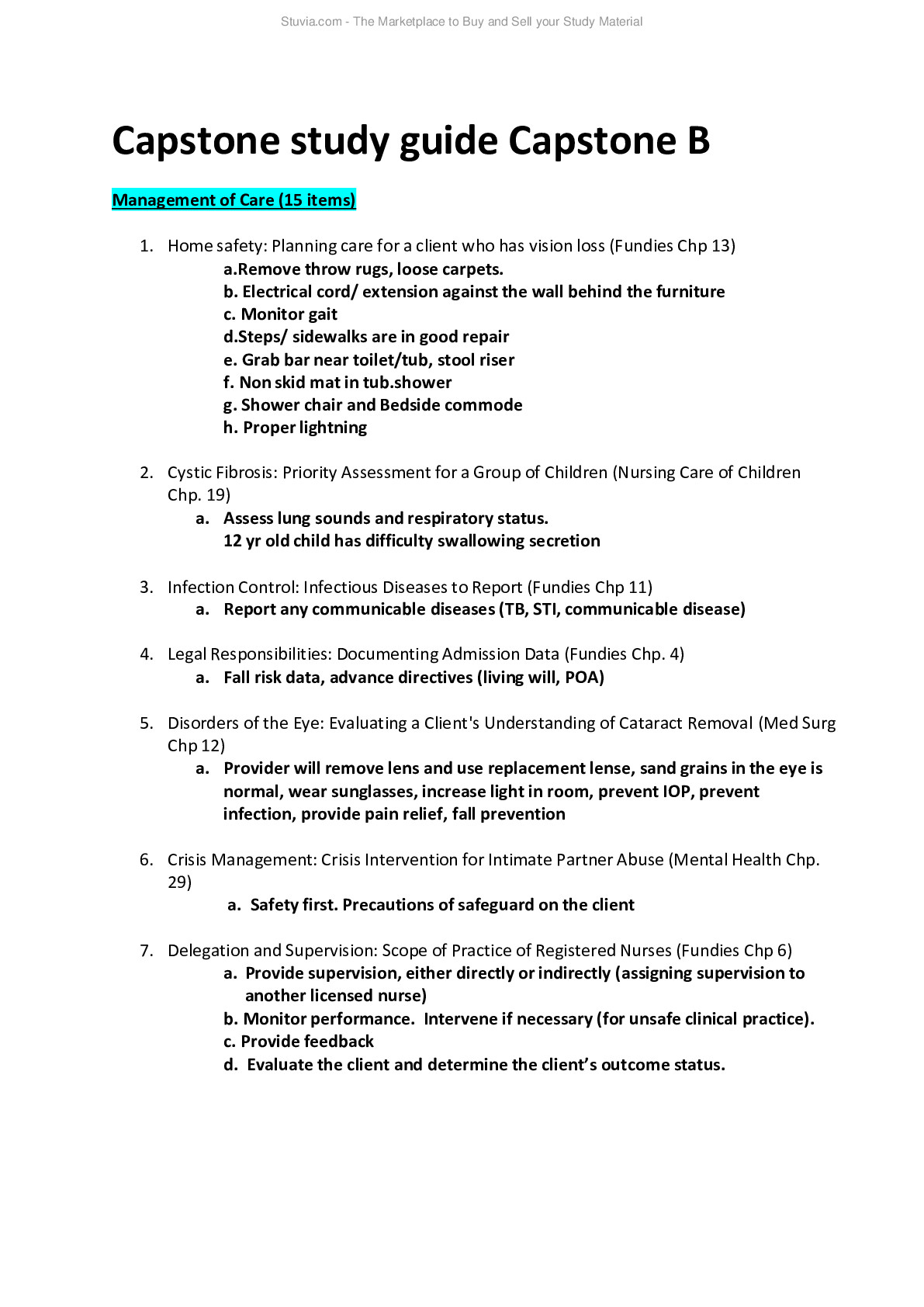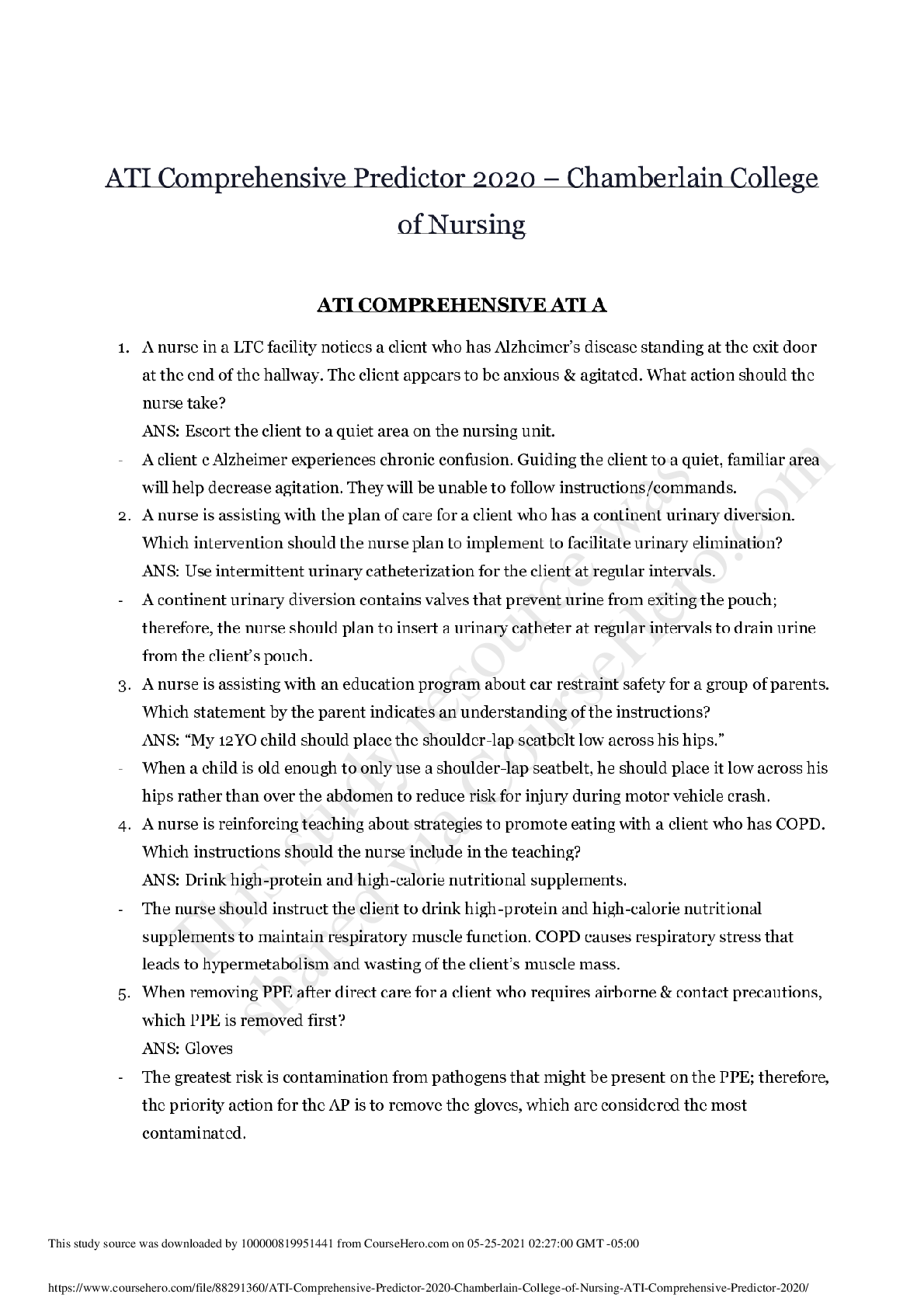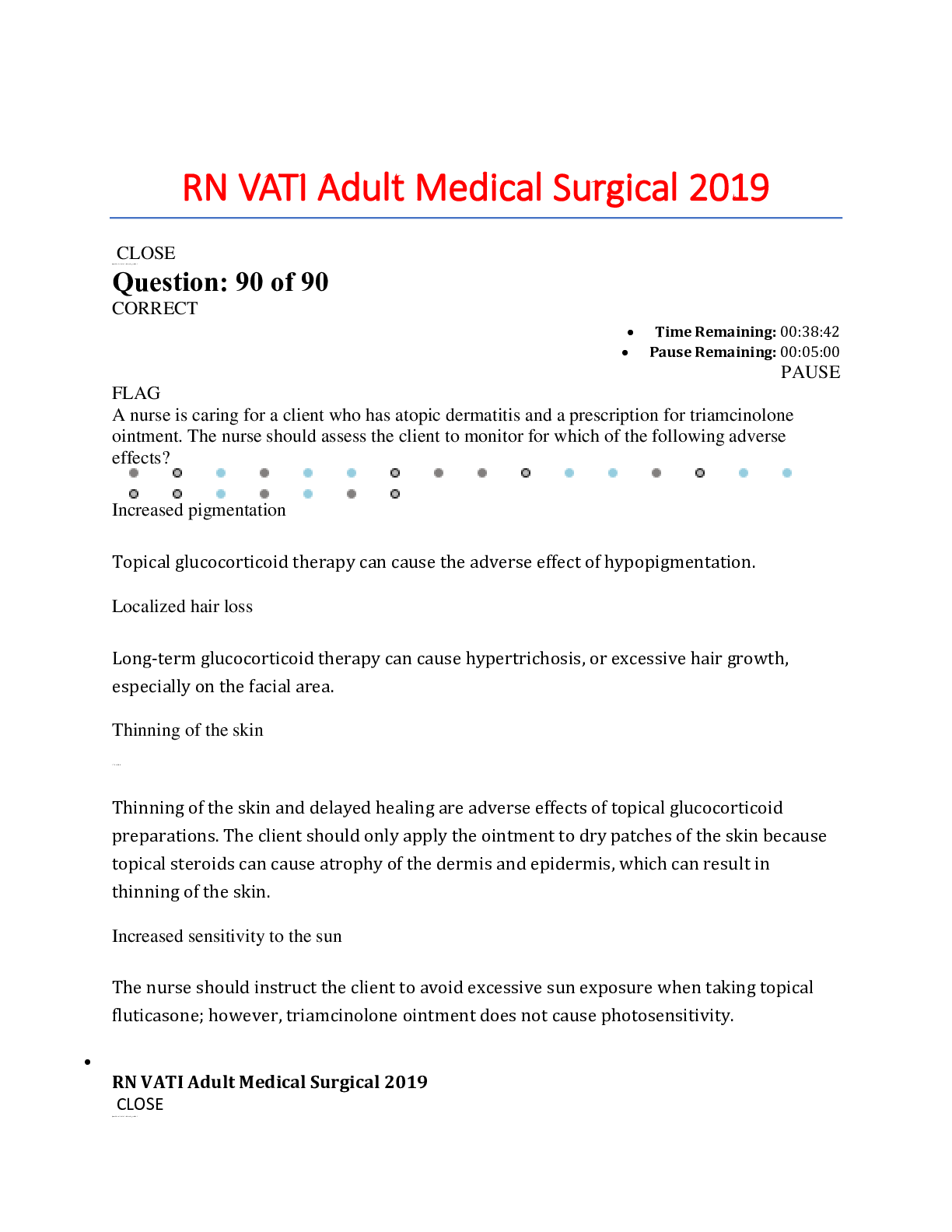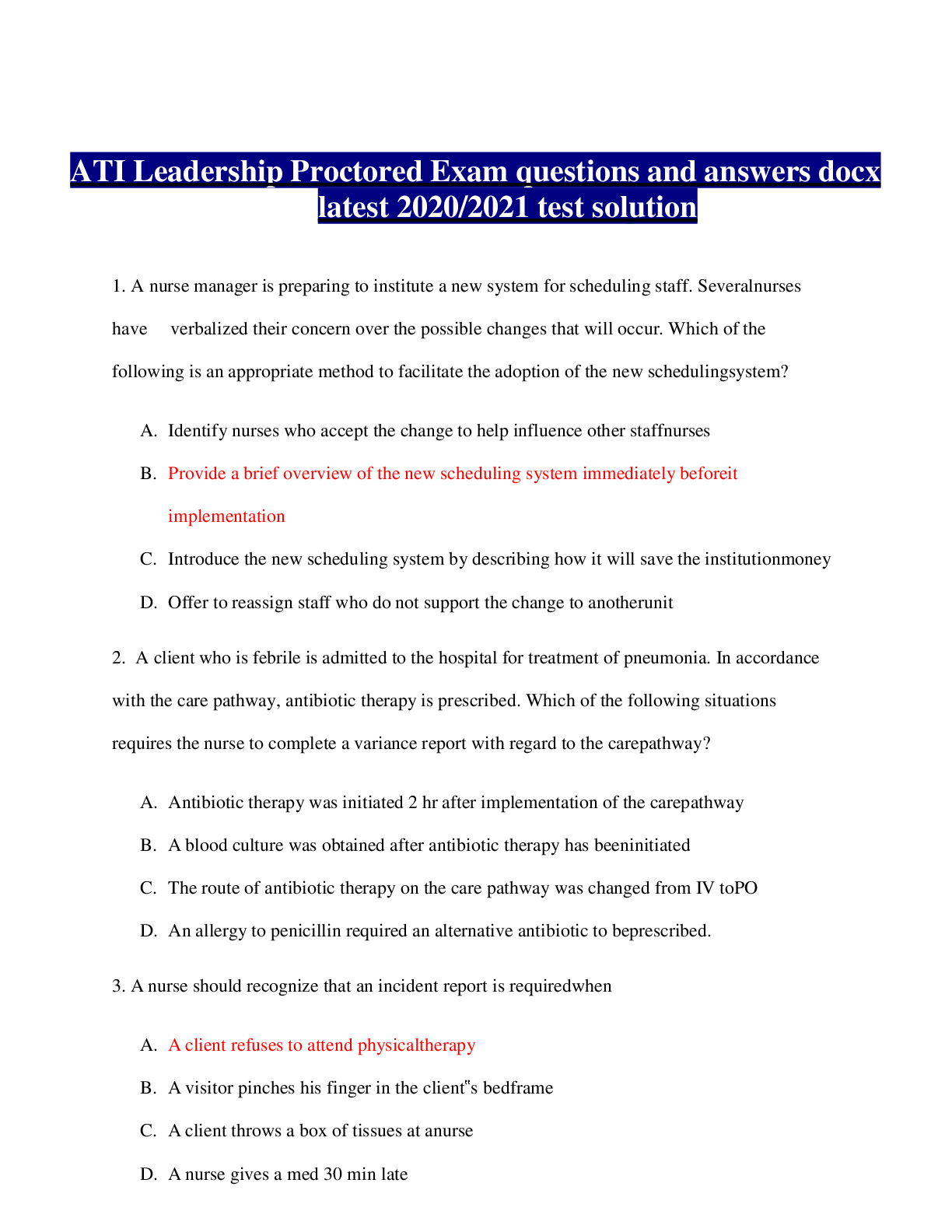Health Care > QUESTIONS and ANSWERS > NR 507 Advanced Pathophysiology (NR 507 Coursework Weeks 1 – 8) Chamberlain College of Nursing (All)
NR 507 Advanced Pathophysiology (NR 507 Coursework Weeks 1 – 8) Chamberlain College of Nursing
Document Content and Description Below
NR 507 Week 1 Case Study: A 35-year-old woman presents to the primary … Read the case study listed Refer to the rubric for grading Utilizing the Week 1 Case Study Template (Links to an external s... ite.), provide your responses to the case study questions listed You must use at least one scholarly reference to provide pathophysiology statements. For this class, use of the textbook for pathophysiology statements is acceptable. You may also use an appropriate evidence-based You must use the Clinical Practice Guideline (CPG) for the management of allergic rhinitis to answer the treatment recommendation questions. The guideline can be found at the following web address: https://journals.sagepub.com/doi/10.1177/0194599814561600 (Links to an external site.) .You may also use a medication administration reference such as Epocrates to provide medication names. Proper APA format (in-text citations, reference page, spelling, English language, and grammar) must be Case Study Scenario A 35-year-old woman presents to the primary care office with a history of nasal congestion that has worsened over time and recurrent sinus infections. She … herself healthy until about 12 months ago when she began experiencing rhinorrhea, sneezing, and nasal stuffiness that “seems to never go away”. She noticed that her rhinorrhea greatly improved when she attended her family reunion on a two-week Caribbean cruise but returned after being home a few days. She lives with her husband and 5- year-old child. They have two household pets: a dog that has lived with them for the last 4 years and a cat who joined the family 1 year ago. Case Study Questions Pathophysiology & Clinical Findings of the Disease Identify the correct hypersensitivity reaction. Explain the pathophysiology associated with the chosen hypersensitivity reaction. Identify at least three subjective findings from the case. Identify at least three objective findings from the case. Management of the Disease *Utilize the required Clinical Practice Guideline (CPG) to support your treatment recommendations. Identify two strongly recommended medication classes for the treatment of the condition and provide an example (drug name) for each. Describe the mechanism of action for each of the medication classes identified above. Identify two treatment options that are NOT recommended (I.e., recommended against) NR 507 Week 2 Discussion: A 72-year-old male presents to the primary … Case Scenario: A 72-year-old male presents to the primary care office with shortness of breath, leg swelling, and fatigue. He reports that he stopped engaging in his daily walk with friends three weeks ago because of shortness of breath that became worse with activity. He decided to come to the office today because he is now propping up on at least 3 pillows at night to sleep. He tells the NP that he sometimes sleeps better in his recliner chair. PMH includes hypertension, hyperlipidemia and Type 2 diabetes. Physical Exam: BP 106/74 mmHg, Heart rate 110 beats per minute (bpm) HEENT: Unremarkable Lungs: Fine inspiratory crackles bilateral bases Cardiac: S1 and S2 regular, rate and rhythm; presence of 3rd heart sound; jugular venous distention. Bilateral pretibial and ankle 2+pitting edema noted ECG: Sinus rhythm at 110 bpm Echocardiogram: decreased wall motion of the anterior wall of the heart and an ejection fraction of 25% Diagnosis: Systolic heart failure, secondary to silent MI Discussion Questions: Differentiate between systolic and diastolic heart State whether the patient is in systolic or diastolic heart Explain the pathophysiology associated with each of the following symptoms: dyspnea on exertion, pitting edema, jugular vein distention, and Explain the significance of the presence of a 3rd heart sound and ejection fraction of 25%. NR 507 Week 3 Case Study: A.C., is a 61-year old male with complaints of shortness of breath… Case Study Scenario Chief Complaint A.C., is a 61-year old male with complaints of shortness of breath. History of Present Illness A.C. was seen in the emergency room 1 week ago for an acute onset of mid-sternal chest pain. The event was preceded with complaints of fatigue and increasing dyspnea for 3 months, for which he did not seek care. He was evaluated by cardiology and underwent a successful and uneventful angioplasty prior to discharge. Despite the intervention, the shortness of breath has not improved. Since starting cardiac rehabilitation, he feels that his breathlessness is worse. The cardiologist has requested that you, his primary care provider, evaluate him for further work-up. Prior to today, his last visit with your practice was 3 years ago when he was seen for acute bronchitis and smoking cessation counseling. Past Medical History Hypertension Hyperlipidemia Atherosclerotic coronary artery disease Smoker Family History Father deceased of acute coronary syndrome at age 65 Mother deceased of breast cancer at age 58. One sister, alive, who is a 5 year breast cancer survivor. One son and one daughter with no significant medical history. Social History 35 pack-year smoking history; he has cut down to one cigarette at bedtime following his cardiac intervention. Denies alcohol or recreational drug use Real estate agent Allergies No Known Drug Allergies Medications Rosuvastatin 20 mg once daily by mouth Carvedilol 25 mg twice daily by mouth Hydrochlorothiazide 12.5 mg once daily by mouth Aspirin 81mg daily by mouth Review of Systems Constitutional: Denies fever, chills or weight loss. + Fatigue. HEENT: Denies nasal congestion, rhinorrhea or sore throat. Chest: + dyspnea with exertion. Denies productive cough or wheezing. + Dry, nonproductive cough in the AM. Heart: Denies chest pain, chest pressure or palpitations. Lymph: Denies lymph node swelling. General Physical Exam Constitutional: Alert and oriented male in no apparent distress. • Vital Signs: BP-120/84, T-97.9 F, P-62, RR-22, SaO2: 93% • Wt. 180 lbs., Ht. 5’9″ HEENT Eyes: Pupils equal, round and reactive to light and accommodation, normal Ears: Tympanic membranes Nose: Bilateral nasal turbinates without redness or swelling. Nares Mouth: Oropharynx No mouth lesions. Dentures well-fitting. Oral mucous membranes dry. Neck/Lymph Nodes Neck supple without No lymphadenopathy, masses or carotid bruits. Lungs Bilateral breath sounds clear throughout lung fields. + Bilaterally wheezes noted with forced exhalation along with a prolonged expiratory phase. No intercostal retractions. Heart S1 and S2 regular rate and rhythm, no rubs or murmurs. Integumentary System Skin cool, pale and Nail beds pink without clubbing. Chest X-Ray Lungs are hyper-inflated bilaterally with a flattened No effusions or infiltrates. Spirometry …… Case Study Questions Pathophysiology & Clinical Findings of the Disease Are the spirometry results consistent with obstructive or restrictive pulmonary disease? What is the most likely pulmonary diagnosis for this patient? Explain the pathophysiology associated with the chosen pulmonary disease. Identify at least three subjective findings from the case which support the chosen diagnosis. Identify at least three objective findings from the case which support the chosen diagnosis. Management of the Disease *Utilize the required Clinical Practice Guideline (CPG) to support your treatment recommendations. Classify the patient’s disease Is this considered stable or unstable? Identify two (2) “Evidence A” recommended medication classes for the treatment of this condition and provide an example (drug name) for each. Describe the mechanism of action for each of the medication classes identified above. Identify two (2) “Evidence A” recommended non-pharmacological treatment options for this patient. NR 507 Week 4 Midterm Solved (Real Exam) Question: Hypertension (high blood pressure) will have its most immediate effect on Question: Mature, circulating RBC’s lack endoplasmic reticulum. Without these structures RBC’s are completely unable to synthesize any Question: Which of the following would indicate that a client with chronic bronchitis has developed secondary polycythemia vera: Question: The amount of blood the heart can hold Question: Glomerulonephritis is … with a(n) Question: Which of the following would not typically … in a client with asthma Question: A prolonged episode of tachycardia will result in Question: Tubular reabsorption and tubular secretion differ in that Question: After erythrocytes have … their lifespan \, they are removed by macrophages … mainly in the Question: Alveolar hyperinflation occurs in asthma and chronic bronchitis as the result of Question: The primary site of damage in the nephron due to ischemic conditions is the Question: The movement of blood into and out of the capillary beds of the lungs to the body tissues and cells describes the process of Question: A 5-year-old female presents with frequent urinary tract infections, imagine studies indicate a retrograde flow of urine from the urinary bladder into the urethers. This is indicative of Question: A 30 year old client who had a gastrectomy procedure 1 year ago is most at risk for the development of Question: A deficiency of intrinsic factor (IF) will most likely result in Question: During ventricular systole Question: A deficiency of transferrin is most likely to result in Question: The primary source of erythropoietin is the Question: Which of the following is not a condition associated with renal failure Question: A 25 year old female presents with frequent complete calculi blockage of one ureter. This is referred to as Question: Contractility of cardia muscle is directly dependent on the level of Question: Appropriate management of progressive renal failure typically includes Question: In addition to oxygen, hemoglobin also carries nitric oxide (NO) No is important for Question: Which equation correctly represents cardiac output (CO) Question: Which of the following statements correctly describes the flow of blood between the heart and lungs Question: Blood (hydrostatic) pressure is most important for the process of Question: Preload can … by all the following except Question: Cardiac tamponade Question: The lamina propria area of the bronchioles play a significant role in the pathogenesis of chronic bronchitis because this is where Question: which of the following will occur when calcium binds to troponin Question: The average red blood cell lifespan is approximately Question: The correct definition of afterload is Question: An accident victim transfused with the incorrect blood type is at most risk for development of Question: A client is experiencing congestive heart failure (CHF) which of the … represent the correct sequence of events that occur with CHF Question: The condition most … with a history of seasonal and/or chronic allergies is Question: Preload refers specifically to Question: ACE (angiotensin converting enzyme) Question: Closure of the semilunar valves (SLV) Question: A 78-year old patient is … for an imaging procedure using contrast dye,. Although rare you know that he may be at risk for contrast … nephropathy (CIN) because of his history of Question: The normal primary site of hematopoiesis in the adult is Question: A 78-year-old male has been … with benign prostatic hyperplasia (BPH) the increases his risk for development of Question: After load can be increase by all the following except Question: The blood disorders sickle-cell anemia and thalassemia are Question: Treatment for asthma included anticholinergic drugs. The mechanism of action for the medication is to Question: A client who is 2 days post-partum is most at risk for development of Question: A client with chronic bronchitis is most likely to experience Question: An aortic semilunar valve stenosis would have the most immediate effect by Question: In the healthy heart the response to an increase in preload is for stroke volume to Question: Decreased contractibility can … by all the following except Question: Cor pulmonale refers to NR 507 Week 5 Discussion: An 84- year-old -female who has a history of diverticular disease… Case Scenario: An 84- year-old -female who has a history of diverticular disease presents to the clinic with left lower quadrant (LLQ) pain of the abdomen that is accompanied by with constipation, nausea, vomiting and a low-grade fever (100.20 F) for 1 day. On physical exam the patient appears unwell. She has signs of dehydration (pale mucosa, poor skin turgor with mild hypotension [90/60 mm Hg] and tachycardia [101 bpm]). The remainder of her exam is normal except for her abdomen where the NP notes a distended, round contour. Bowel sounds a faint and very hypoactive. She is tender to light palpation of the LLQ but without rebound tenderness. There is hyper-resonance of her abdomen to percussion. The following diagnostics reveal: Stool for occult blood is positive. Flat plate abdominal x-ray demonstrates a bowel-gas pattern consistent with an ileus. Abdominal CT scan with contrast shows no evidence of a mass or abscess. Small bowel in distended. Based on the clinical presentation, physical exam and diagnostic findings, the patient is … with acute diverticulitis and she is … to the hospital. She is … intravenous antibiotics and fluids (IVF). Her symptoms … and she could tolerate a regular diet before she was discharged to home. Discussion Questions: Compare and contrast the pathophysiology between diverticular disease (diverticulosis) and Identify the clinical findings from the case that supports a diagnosis of acute diverticulitis. List 3 risk factors for acute diverticulitis. Discuss why antibiotics and IV fluids are indicated in this case. NR 507 Week 6 Case Study: J.T. is a 48-year old male who presents …. Case Study Scenario Chief Complaint J.T. is a 48-year old male who presents to the primary care clinic with fatigue, weight loss, and extreme thirst and increased appetite. History of Present Illness J.T. has been in his usual state of health until three weeks ago when he began experiencing symptoms of fatigue, weight loss, and extreme thirst. He reports that he would like to begin a walking program, but he feels too fatigued to walk at any point during the day. Now he is very concerned about gaining more weight since he is eating more. He reports insomnia due to having to get up and urinate greater than 4 times per night. Past Medical History Hypertension Hyperlipidemia Obesity Family History Both parents deceased Brother: Type 2 diabetes Social History Denies smoking Denies alcohol or recreational drug use Landscaper Allergies No Known Drug Allergies Medications Lisinopril 20 mg once daily by mouth Atorvastatin 20 mg once daily by mouth Aspirin 81 mg once daily by mouth Multivitamin once daily by mouth Review of Systems Constitutional: – fever, – chills, – weight loss. Neurological: denies dizziness or disorientation HEENT: Denies nasal congestion, rhinorrhea or sore throat. Chest: + Denies cough. Heart: Denies chest pain, chest pressure or palpitations. Lymph: Denies lymph node swelling. General Physical Exam Constitutional: Alert and oriented male in no acute distress Vital Signs: BP-136/80, T-98.6 F, P-78, RR-20 Wt. 240 lbs., Ht. 5’8″, BMI 36.5 HEENT Eyes: Pupils equal, round and reactive to light and accommodation, normal conjunctiva. Ears: Tympanic membranes intact. Nose: Bilateral nasal turbinates without redness or swelling. Nares patent. Mouth: Oropharynx No mouth lesions. Teeth present and intact; Oral mucous membranes and lips dry. Neck/Lymph Nodes Neck supple without JVD. No lymphadenopathy, masses or carotid bruits. Lungs Bilateral breath sounds clear throughout lung fields. Breathing quality deep with fruity breath odor Heart S1 and S2 regular rate and rhythm; tachycardia; no rubs or murmurs. Integumentary System Skin warm, dry; Nail beds pink without clubbing. Labs J.T. is diagnosed with diabetes. Review all information provided in the case to answer the following questions. Case Study Questions Pathophysiology & Clinical Findings of the Disease Review the lab findings and decide if the diagnosis is Type 2 or Type 1 Diabetes Mellitus. Explain the pathophysiology associated with your chosen diagnosis Identify at least three subjective findings from the case which support the chosen diagnosis. Identify at least three objective findings from the case which support the chosen diagnosis. Management of the Disease *Utilize the required Clinical Practice Guideline (CPG) to support your treatment recommendations. Identify two (2) “Evidence A” recommended medication classes for the treatment of this condition and provide an example (drug name) for each. Describe the mechanism of action for each of the medication classes identified above. Identify two (2) “Evidence A” recommended non-pharmacological treatment options for this patient. Utilizes the required Clinical Practice Guideline (CPG) to support the chosen treatment recommendations NR 507 Week 7 Discussion: A 76-year -old man is brought to the primary Case Scenario A 76-year -old man is brought to the primary care office by his wife with concerns about his worsening memory. He is a retired lawyer who has recently been getting lost in the neighborhood where he has lived for 35 years. He was recently found wandering and has often been brought home by neighbors. When asked about this, he becomes angry and defensive and states that he was just trying to go to the store and get some bread. His wife expressed concerns about his ability to make decisions as she came home two days ago to find that he allowed an unknown individual into the home to convince him to buy a home security system which they already have. He has also had trouble dressing himself and balancing his checkbook. At this point, she is considering hiring a day-time caregiver help him with dressing, meals and general supervision why she is at work. Past Medical History: Gastroesophageal reflux (treated with diet); is negative for hypertension, hyperlipidemia, stroke or head injury or depression Allergies: No known allergies Medications: None Family History Father deceased at age 78 of decline related to Alzheimer’s disease Mother deceased at age 80 of natural causes No siblings Social History Denies smoking Denies alcohol or recreational drug use Retired lawyer Hobby: Golf at least twice a week Review of Systems Constitutional: Denies fatigue or insomnia HEENT: Denies nasal congestion, rhinorrhea or sore throat. Chest: Denies dyspnea or coughing Heart: Denies chest pain, chest pressure or palpitations. Lymph: Denies lymph node swelling. Musculoskeletal: denies falls or loss of balance; denies joint point or swelling General Physical Exam Constitutional: Alert, angry but cooperative Vital Signs: BP-128/72, T-98.6 F, P-76, RR-20 Wt. 178 lbs., Ht. 6’0″, BMI 24.1 HEENT Head normocephalic; Pupils equal and reactive to light bilaterally; EOM’s intact Neck/Lymph Nodes No abnormalities noted Lungs Bilateral breath sounds clear throughout lung fields. Heart S1 and S2 regular rate and rhythm, no rubs or murmurs. Integumentary System Warm, dry and intact. Nail beds pink without clubbing. Neurological Deep tendon reflexes (DTRs): 2/2; muscle tone and strength 5/5; no gait abnormalities; sensation intact bilaterally; no aphasia Diagnostics Mini-Mental State Examination (MMSE): Baseline score 12 out of 30 (moderate dementia) MRI: hippocampal atrophy Based on the clinical presentation and diagnostic findings, the patient is diagnosed with Alzheimer’s type dementia. Discussion Questions Compare and contrast the pathophysiology between Alzheimer’s disease and frontotemporal dementia. Identify the clinical findings from the case that supports a diagnosis of Alzheimer’s disease. Explain one hypothesis that explains the development of Alzheimer’s disease Discuss the patient’s likely stage of Alzheimer’s disease. NR-507 Week 8 Final Exam (Actual Exam Solutions) (Version 1. 50Q & A) Question: What phrase describes the condition in which a series of alveoli in the left lower lobe receive adequate ventilation but lack adequate perfusion? Question: A function of the pericardium is to: Question: Clinical manifestations of bile salt deficiencies are r/t poor absorption of: Question: The FNP is teaching the community about health promotion. Which information should the FNP include for innate immunity? Question: A 10 y/o develops pneumonia. Physical exam reveals subcostal and intercostal retractions. The children ports that breathing is difficult with feelings that, “I can’t get enough ” What term should the FNP use to document this condition? Question: When the FNP is reviewing lab results & notices that the erythrocytes contain an abnormally low concentration of hgb, the nurse calls these erythrocytes: Question: A45y/o/mcom plains of heart burn after eating & difficulty swallowing. These symptoms support which diagnosis? Question: A25y/o/f has a heavy menses during which she loses a prof use amount of blood. Which of the following adaptations should the nurse expect? Question: Which pt will develop active immunity? A pt who: Question: Chronic gastritis is … according to the: Question: A16y/o/f student is driving to school when another driver nearly hits Her heart begins beating harder & faster as she becomes … & scared. Which of the following states of the general adaptation syndrome is she experienced? Question: 50 y/o is diagnosed with gastro esophageal reflux. This condition is: Question: A low ventilation-perfusion ratio of the lung will result in: Question: A52y/o/mis … with urinary tract obstruction. While designing the treatment plan, the nurse realizes that the pt is expected to have hydronephrosis & a … glomerular filtration rate caused by: Question: A40y/o/m’shx includes being a vegetarian & abusing alcohol. Which of the following factors put him at greatest risk for developing folate deficiency anemia? Question: A 20 u/o underwent an echocardiogram to assess chest pain. Results revealed a congenital defect in the papillary muscles. Which of the following would the nurse expect to occur? Question: A58y/o/f presents in the clinic with fatigue, weight loss, and tingling of her fingers. Laboratory findings show low hgb & hct, a high mean corpuscular volume, & normal plasma iron. These assessment findings are consistent with which type of anemia? Question: A 54 y/o/m with a long hx of smoking presents with a chief concern of excessive tiredness, sob, & overall ill feelings. Lab results reveal decreased pH, CO2, & normal bicarbonate ion. These findings help to confirm the diagnosis of: Question: A 50 y/o/m reports episodes of frequently recurring crampy abdpain, diarrhea & bloody stools. A possible diagnosis would be: Question: As a result of blockage in the pulmonary artery, blood would first back up into the: Question: What is the most likely cause of croup? Question: A pt’s anemia is … as having erythrocytes that demonstrate poikilocytosis. The FNP would recognize the erythrocytes would … : Question: A newborn is diagnosed with respiratory distress syndrome. When obtaining the pt’s hx, which of the following is the most important predisposing factor for this condition? Question: Which of the following is responsible for initiating clonal selection? Question: A 39 y/o is … with a duodenal Which of the following behaviors mays have … to the development of the development of the ulcer? Question: A 50 y/o/m recently underwent a liver transplant & is taking immunosuppressive drugs. He now has painful vesicular eruptions on the face & trunk. He reports that he had chickenpox as a child. Which of the following is the most likely diagnosis … on his chicken pox history? Question: A 5 y/o presents to the clinic with high fever, inspiratory stridor, severe respiratory distress, drooling, & dysphagia. Acute epiglottis is suspected. When assessing the child, the FNP should avoid: Question: A44y/o patient who demonstrates chronic gastro intestineal bleeding is … with anemia. What is the primary cause of the pt’s anemia? Question: Biochemical secretions that trap & kill microorganisms include: Question: Which statement indicates a correct understanding of anti-bodies? The most abundant class of antibody in the serum is: Question: A patient with primary hyperparathyroidism will have which of the following lab changes? Question: Which of the following is the most common cause of hypothyroidism? Question: Which of the following hormones contributes to the development of insulin resistance in the gastrointestinal? Question: Which of the following is … in the treatment of hyperthyroidism? Question: Which of the following lab results indicates primary hypocortisolism? Question: Which of the following is a sensory deficit that is … with basilar artery infarct? Question: Which electrolyte inhibits Parathyroid hormone (PTH)secretion? Question: Which of the following occurs in hyper cortisolism? Question: Which of the following is a trigger for the development of rosacea? Question: Which of the following is a symptom of a manic episode? Question: Where is peptic ulcer disease least likely to occur? Question: A 26-year-old female presents to the clinic with a 4 month history of intermittent abdominal pain that feels like “burning in the upper part of my stomach. “It occurs most often 1 hour after a meal. These symptoms are consistent with what type of ulcer? Question: Which of the following statements is true regarding major depressive disorder? Question: The most common cause of cirrhosis is? Question: The monoamine hypothesis depression indicates that the under lying cause of depression is due to which of the following? Question: Which of the following is characteristic of Type 1Diabetes? Question: A patient with Diabetes Mellitus experiencing delayed gastric emptying. What type of neuropathy is the patient experiencing? Question: Which of the following scores of the Mini-Mental Exam (MMSE) would indicate severe Alzheimer’s type dementia? Question: The risk factors for the development of Ulcerative Colitis and Crohn’s disease are similar except which factor? Question: Which of the following is a risk factor for the development of GERD? NR-507 Week 8 Final Exam (Actual Exam Solutions) (Version 2. 120Q & A) NR507 Week 8 Final Exam / NR 507 Week 8 Final Exam (Latest): Advanced Pathophysiology: Chamberlain College of Nursing Chamberlain NR 507 Final Exam / Chamberlain NR507 Final Exam (Latest): Advanced Pathophysiology Question 1 What is the major virus involved in the development of cervical cancer? a) Herpes simplex virus type 6 b) Herpes simplex virus type 2 c) Human papillomavirus d) Human immunodeficiency virus Question 2 Which statement accurately describes childhood asthma? a) An obstructive airway disease characterized by reversible airflow obstruction, bronchial hyperreactivity, and inflammation b) A pulmonary disease characterized by severe hypoxemia, decreased pulmonary compliance, and diffuse densities on chest x-ray imaging c) A pulmonary disorder involving an abnormal expression of a protein, producing viscous mucus that lines the airways, pancreas, sweat ducts, and vas deferens d) An obstructive airway disease characterized by atelectasis and increased pulmonary resistance as a result of a surfactant deficiency Question 3 The ability of the pathogen to invade and multiply in the host is referred to as: a) Infectivity b) Toxigenicity c) Pathogenicity d) Virulence Question 4 Obesity creates a greater risk for dehydration in people because: a) Adipose cells contain little water because fat is water repelling. b) The metabolic rate of obese adults is slower than the rate of lean adults. c) The rate of urine output of obese adults is higher than the rate of output of lean adults. d) The thirst receptors of the hypothalamus do not function effectively. Question 5 Continued therapy of pernicious anemia (PA) generally lasts how long? a) 6 to 8 weeks b) 8 to 12 months c) Until the iron level is normal d) The rest of one’s life Question 6 Which statement best describes cystic fibrosis? a) Obstructive airway disease characterized by reversible airflow obstruction, bronchial hyperreactivity, and inflammation b) Respiratory disease characterized by severe hypoxemia, decreased pulmonary compliance, and diffuse densities on chest x- ray imaging c) Pulmonary disorder involving an abnormal expression of a protein-producing viscous mucus that obstructs the airways, pancreas, sweat ducts, and vas deferens d) Pulmonary disorder characterized by atelectasis and increased pulmonary resistance as a result of a surfactant deficiency Question 7 What pulmonary defense mechanism propels a mucous blanket that entraps particles moving toward the oropharynx? a) Nasal turbinates b) Alveolar macrophages c) Cilia d) Irritant receptors on the nares Question 8 As stated in the Frank-Starling law, a direct relationship exists between the of the blood in the heart at the end of diastole and the of contraction during the next systole. a) Pressure; force Volume; b) strength Viscosity; c) force Viscosity; strength Question 9 : a) 2 years b) 1 year c) 10 months d) 5 months Question 10 Carcinoma refers to abnormal cell proliferation originating from which tissue origin? a) Blood vessels b) Epithelial cells c) Connective tissue d) Glandular tissue Question 11 Which of the following describes how the body compensates for anemia? a) Increasing rate and depth of breathing b) Decreasing capillary vasoconstriction c) Hemoglobin holding more firmly onto oxygen d) Kidneys releasing more erythropoietin Question 12 What term is used to describe a hernial protrusion of a saclike cyst that contains meninges, spinal fluid, and a portion of the spinal cord through a defect in a posterior arch of a vertebra? a) Encephalocele b) Meningocele c) Spina bifida occulta d) Myelomeningocele Question 13 Chvostek and Trousseau signs indicate which electrolyte imbalance? a) Hypokalemia b) Hyperkalemia c) Hypocalcemia d) Hypercalcemia Question 14 After sexual transmission of HIV, a person can be infected yet seronegative for how many months? a) 1 to 2 b) 6 to 14 c) 18 to 20 d) 24 to 36 Question 15 Which hormone prompts increased anxiety, vigilance, and arousal during a stress response? a) Norepinephrine b) Epinephrine c) Cortisol d) Adrenocorticotropic hormone (ACTH) Question 16 Which blood cells are the chief phagocytes involved in the early inflammation process? a) Neutrophils b) Monocytes c) Eosinophils d) Erythr Question 17 Where are alveolar macrophages found? a) Skin b) Breasts c) Gastrointestinal tract d) Lungs Question 18 Which normal physiologic change occurs in the aging pulmonary system? a) Decreased flow resistance b) Fewer alveoli c) Stiffening of the chest wall d) Improved elastic recoil Question 19 An infant diagnosed with a small patent ductus arteriosus (PDA) would likely exhibit which symptom? a) Intermittent murmur b) Lack of symptoms c) Need for surgical repair d) Triad of congenital defects Question 20 Hemophilia B is caused by a deficiency of which clotting factor? a) V b) VIII c) IX d) X Question 21 A hypersensitivity reaction that produces an allergic response is called: a) Hemolytic shock b) Anaphylaxis c) Necrotizing vasculitis d) Systemic erythematosus Question 22 Which statement is true regarding pain and cancer? a) Pain is primarily a result of pressure caused by the tumor. b) Pain indicates the metastasis of a cancer. c) Pain is usually the initial symptom of cancer. d) Pain is generally associated with late-stage cancer. Question 23 What is the anomaly in which the soft bony component of the skull and much of the brain is missing? a) Anencephaly b) Myelodysplasia c) Cranial meningocele d) Hydrocephaly Question 24 At birth, which statement is true? a) Systemic resistance and pulmonary resistance fall. b) Gas exchange shifts from the placenta to the lung. c) Systemic resistance falls and pulmonary resistance rises. d) Systemic resistance and pulmonary resistance rise. Question 25 What is the most commonly reported symptom of cancer treatment? a) Nausea b) Fatigue c) Hair loss d) Weight loss Question 26 a The common property among the three types of medications used to treat depression is that theya:) Increase neurotransmitter levels within the synapse. b) Increase neurotransmitter levels in the presynapse. c) Decrease neurotransmitter levels in the postsynapse. d) Decrease neurotransmitter levels within the synapse. Question 27 Prolonged high environmental temperatures that produce dehydration, decreased plasma volumes, hypotension, decreased cardiac output, and tachycardia cause which disorder of temperature regulation? a) Heat cramps b) Heat stroke c) Malignant hyperthermia d) Heat exhaustion Question 28 Congenital aganglionic megacolon (Hirschsprung disease) involves inadequate motility of the colon caused by neural malformation of which nervous system? a) Central b) Parasympathetic c) Sympathetic d) Somatic Question 29 What type of fracture occurs at a site of a preexisting bone abnormality and is a result of a force that would not normally cause a fracture? a) Idiopathic b) Incomplete c) Pathologic d) Greenstick Question 30 What is the leading cause of infertility in women? a) Pelvic inflammatory disease b) Endometriosis c) Salpingitis dstic ovary syndrome Question 31 Alterations in which part of the brain are linked to hallucinations, delusions, and thought disorders associated with schizophrenia? a) Parietal lobe b) Limbic system c) Temporal lobe d) Hypothalamus . Question 32 What is the function of the mucus secreted by the Bartholin glands? a) Enhancement of the motility of sperm b) Lubrication of the urinary meatus and vestibule c) Maintenance of an acid-base balance to discourage proliferation of pathogenic bacteria d) Enhancement of the size of the penis during intercourse Question 33 People with gout are at high risk for which co-morbid condition? a) Renal calculi b) Joint trauma c) Anemia d) Hearing loss Question 34 The tear in a ligament is referred to as a: a) Fracture b) Strain c) Disunion d) Sprain Question 35 Regarding type 2 diabetes, obesity is considered to be what type of risk? a) Genetic b) Empirical c) Relative d) Modifiable Question 36 Adoption studies have shown that the offspring of an alcoholic parent when raised by nonalcoholic parents have what amount of an increased risk of developing alcoholism? a) Twofold b) Threefold c) Fourfold d) Tenfold Question 37 What causes the crystallization within the synovial fluid of the joint affected by gouty arthritis? a) Reduced excretion of purines b) Overproduction of uric acid c) Increase in the glycosaminoglycan levels d) Overproduction of proteoglycans Question 38 It is true that Guillain-Barré syndrome (GBS): a) Is preceded by a viral illness. b) Involves a deficit in acetylcholine. c) Results in asymmetric paralysis. d) Is an outcome of HIV. Question 39 The failure of bones to ossify, resulting in soft bones and skeletal deformity, characterizes which disorder? a) Osteogenesis imperfecta b) Rickets c) Osteochondrosis d) Legg-Calvé-Perthes disease Question 40 Which dietary lifestyle choice has been associated with a decreased risk for developing colon cancer? a) Increased consumption of dairy produces b) Increased consumption of foods containing vitamin C c) Decreased consumption of foods high in fat d) Decreased consumption of artificial food coloring Question 41 The sudden apparent arousal in which a child expresses intense fear or another strong emotion while still in a sleep state characterizes which sleep disorder? a) Night terrors b) Insomnia c) Somnambulism d) Enuresis Question 42 Which virus is a precursor for developing cervical intraepithelial neoplasia (CIN) and cervical cancer? a) Human papillomavirus (HPV) b) Epstein-Barr virus (EBV) c) Herpes simplex II virus (HSV) d) Cytomegalovirus (CMV) Question 43 What anchors articular cartilage to the underlying bone? a) Sharpey fibers b) Collagen fibers c) Glycoproteins d) Elastin fibers Question 44 2/ 2 pts Which gastric cells secrete hydrochloric acid and intrinsic factor? a) Parietal b) Chief c) G d) H Question 45 Which water-soluble vitamin is absorbed by passive diffusion? a) Vitamin B6 b) Vitamin B1 c) Vitamin K d) Folic acid Question 46 What is the first sign of puberty in girls? a) Breast enlargement b) Growth of pubic hair c) Menstruation d) Vaginal discharge Question 47 Pinkeye is characterized by inflammation of which structure? a) Eyelids b) Sebaceous glands c) Meibomian glands d) Conjunctiva Question 48 What syndrome, characterized by an absent homologous X chromosome with only a single X chromosome, exhibits features that include a short stature, widely spaced nipples, and webbed neck? a) Down b) Cri du chat c) Turner d) Klinefelter Question 49 A criterion for a diagnosis of generalized anxiety disorder (GAD) is a period of excessive worrying that lasts for at least how many months? a) 3 b) 6 c) 9 d) 12 Question 50 Obesity acts as an important risk factor for type 2 diabetes mellitus by: a) Reducing the amount of insulin the pancreas produces b) Increasing the resistance to insulin by cells c) Obstructing the outflow of insulin from the pancreas d) Stimulating the liver to increase glucose production Question 51 Which clinical manifestations would be expected for a child who has complete trisomy of the twenty-first chromosome? a) Widely spaced nipples, reduced carrying angle at the elbow, and sparse body hair b) An IQ of 25 to 70, low nasal bridge, protruding tongue, and flat, low-set ears c) High-pitched voice, tall stature, gynecomastia, and an IQ of 60 to 90 d) Circumoral cyanosis, edema of the feet, short stature, and mental slowness Question 52 Where is the usual site of cervical dysplasia or cancer in situ? a) Squamous epithelium of the cervix meets the cuboidal epithelium of the vagina. b) Columnar epithelium of the cervix meets the squamous epithelium of the uterus. c) Squamous epithelium of the cervix meets the columnar epithelium of the uterus. d) Columnar epithelium of the cervix meets the squamous epithelium of the vagina. Question 53 How can glaucoma cause blindness? a) Infection of the cornea b) Pressure on the optic nerve c) Opacity of the lens d) Obstruction of the venous return from the retina Question 54 Parkinson disease is a degenerative disorder of the brain’s: a) Hypothalamus b) Anterior pituitary c) Frontal lobe d) Basal ganglia Question 55 Which pain theory proposes that a balance of impulses conducted from the spinal cord to the higher centers in the central nervous system (CNS) modulates the transmission of pain? a) GCT Pattern theory b) Specificity theory c) Neuromatrix theory Question 56 Where is oxytocin synthesized? a) Hypothalamus b) Paraventricular nuclei c) Anterior pituitary d) Posterior pituitary Question 57 An insufficient dietary intake of which vitamin can lead to rickets in children? a) C b) B12 c) B6 d) D Question 58 What term is used to identify the condition that exists when the urethral meatus is located on the undersurface of the penis? a) Hypospadias b) Epispadias c) Hyperspadias d) Chordee Question 59 The most critical aspect in ly diagnosing a seizure disorder and establishing its cause is: a) Computed tomographic (CT) scan b) Cerebrospinal fluid analysis c) Skull x-ray studies d) Health history Question 60 Transcription is best defined as a process by which: a) DNA polymerase binds to the promoter site on ribonucleic acid (RNA). b) RNA directs the synthesis of polypeptides for protein synthesis. c) RNA is synthesized from a DNA template. d) A base pair substitution results in a mutation of the amino acid sequence. Question 61 Which person is at the greatest risk for developing delirium? a) An individual with diabetes celebrating a 70th birthday b) A depressed Hispanic woman c) An individual on the second day after hip replacement d) A man diagnosed with schizophrenia Question 62 Which hormone is linked to an increase in appetite during puberty? a) Inhibin b) Leptin c) Activin d) Follistatin Question 63 Which type of diarrhea results from lactose intolerance? a) Secretory b) Motility c) Osmotic d) Small volume Question 64 An amniocentesis is recommended for pregnant women who: a) Have a history of chronic illness b) Have a family history of genetic disorders c) Have experienced in vitro fertilization d) Had a late menarche Question 65 Which characteristic is true of type II (white fast-motor) muscle fibers? a) Slow contraction speed b) Fast conduction velocities c) Profuse capillary supply d) Oxidative metabolism Question 66 a) The mucosal secretions of the cervix secrete which immunoglobulin? IgA b) IgE c) IgG d) IgM Question 67 Dilation of the ipsilateral pupil, following uncal herniation, is the result of pressure on which cranial nerve (CN)? a) Optic (CN I) b) Abducens (CN VI) c) Oculomotor (CN III) d) Trochlear (CN IV) Question 68 Which of the following is a lipid-soluble hormone? a) Cortisol b) Oxytocin c) Epinephrine d) Growth hormone Question 69 What is the first indication of nephrotic syndrome in children? a) Periorbital edema b) Scrotal or labial edema c) Frothy urine d) Ascites Question 70 The BRCA1 and BRCA2 mutations increase the risk of which cancer in women? a) Ovarian b) Lung c) Uterine d) Pancreatic Question 71 The data reporting that sickle cell disease affects approximately 1 in 600 American blacks is an example of which concept? a) Incidence b) Prevalence c) Ratio d) Risk Question 72 When a woman’s uterus is assessed as protruding through the entrance of the vagina to the hymen, which grade of prolapse does this indicate? a) 0 b) 1 c) 2 d) 3 Question 73 What is the term that denotes the duration of time or the intensity of pain that a person will endure before outwardly responding? a) Tolerance b) Perception c) Threshold d) Dominance Question 74 Clinical manifestations that include irregular or heavy bleeding, the passage of large clots, and the depletion of iron stores support which diagnosis? a) Premenstrual syndrome b) Dysfunctional uterine bleeding c) Polycystic ovary syndrome d) Primary dysmenorrhea Question 75 What term describes the loss of the comprehension or production of language? a) Agnosia b) Aphasia c) Akinesia d) Dysphasia Question 76. : The common hay fever allergy is expressed through a reaction that is mediated by which class of immunoglobulins? a) IgE b) IgG c) IgM d) T cells Question 77 : What is the treatment of choice for pernicious anemia (PA)? a) Cyanocobalamin by oral intake b) Vitamin B12 by injection c) Ferrous fumarate by Z-track injection d) Folate by oral intake Question 78. : Which sexually transmitted infection frequently coexists with gonorrhea? a) Syphilis b) Herpes simplex virus c) Chlamydia d) Chancroid Question 79. : During an infection, why do lymph nodes enlarge and become tender? a) B lymphocytes proliferate. b) The nodes are inflamed. c) The nodes fill with purulent exudate. d) The nodes are not properly functioning. Question 80. : What is the suggested mean blood pressure for an 8- to 9-year-old child? a) 104/55 mm Hg b) 106/58 mm Hg c) 112/62 mm Hg d) 121/70 mm Hg Question 81. : Stress-induced sympathetic stimulation of the adrenal medulla causes the secretion of: a) Epinephrine and aldosterone b) Norepinephrine and cortisol c) Epinephrine and norepinephrine d) Acetylcholine and cortisol Question 82. : What is the function of erythrocytes? a) Tissue oxygenation b) Hemostasis c) Infection control d) Allergy response Question 83. Where are Kupffer cells located? a) Kidneys b) Liver c) Pancreas d) Spleen Question 84. Tissue damage caused by the deposition of circulating immune complexes containing an antibody against the host DNA is the cause of which disease? a) Hemolytic anemia b) Pernicious anemia c) Systemic lupus erythematosus d) Myasthenia gravis \Question 85. Where are Langerhans cells found? a) Skin b) Intestinal lining c) Kidney d) Thyroid Question 86. What is the primary cause of the symptoms of polycythemia vera? a) Decreased erythrocyte count b) Destruction of erythrocytes c) Increased blood viscosity d) Neurologic involvement Question 87. How is the effectiveness of vitamin B12 therapy measured? a) Reticulocyte count b) Serum transferring c) Hemoglobin d) Serum vitamin B12 Question 88. Which is an example of an endogenous antigen? a) Yeast b) Cancer cells c) Bacteria d) Fungus Question 89. Which immunoglobulin is present in blood, saliva, breast milk, and respiratory secretions? a) IgA b) IgE c) IgG d) IgM Question 90. Which renal change is found in older adults? a) Sharp decline in glomerular filtration rate b) Sharp decline in renal blood flow c) Decrease in the number of nephrons d) Decrease in urine output Question 91. What period follows depolarization of the myocardium and represents a period during which no new cardiac potential can be propagated? a) Refractory b) Hyperpolarization c) Threshold d) Sinoatrial (SA) Question 92. What is the most common predisposing factor to obstructive sleep apnea in children? a) Chronic respiratory infections b) Adenotonsillar hypertrophy c) Obligatory mouth breathing d) Paradoxic breathing Question 93. Kidney stones in the upper part of the ureter would produce pain referred to which anatomical area? a) Vulva or penis b) Umbilicus c) Thighs d) Lower abdomen Question 94. What characteristic do atopic individuals have that make them genetically predisposed to develop allergies? a) Greater quantities of histamine b) More histamine receptors c) Greater quantities of IgE d) A deficiency in epinephrine Question 95. Pressure in the left ventricle must exceed pressure in which structure before the left ventricle can eject blood? a) Superior vena cava b) Aorta c) Inferior vena cava d) Pulmonary veins Question 96. How does chest wall compliance in an infant differ from that of an adult? a) An adult’s chest wall compliance is lower than an infant’s. b) An adult’s chest wall compliance is higher than an infant’s. c) An adult’s chest wall compliance is the same as an infant’s. d) An adult’s chest wall compliance is dissimilar to that of an infant’s. Question 97. Oxygenated blood flows through which vessel? a) Superior vena cava b) Pulmonary veins c) Pulmonary artery d) Coronary veins Question 98. What type of immunity is produced when an immunoglobulin crosses the placenta? a) Passive-acquired immunity b) Active-acquired immunity c) Passive-innate immunity d) Active-innate immunity Question 99. The concentration of the final urine is determined by antidiuretic hormone (ADH), which is secreted by which gland? a) Posterior pituitary b) Thyroid c) Parathyroid d) Anterior pituitary Question 100. Exhaustion occurs if stress continues when which stage of the general adaptation syndrome is not successful? a) Flight or fight b) Alarm c) Adaptation d) Arousal \Question 101. When the maternal immune system becomes sensitized against antigens expressed by the fetus, what reaction occurs? a) T-cell immunity b) Alloimmunity c) Fetal immunity d) Autoimmunity Question 102. What is the basic structural unit in compact bone? a) Small channels called canaliculi b) Osteocytes within the lacunae c) Tiny spaces within the lacunae d) Haversian system Question 103. Which type of fracture usually occurs in an individual who engages in a new activity that is strenuous and repetitive? a) Stress b) Greenstick c) Insufficiency d) Pathologic Question 104. Antipsychotic drugs block which neurotransmitter receptor? a) Norepinephrine b) Gamma-aminobutyric acid c) Serotonin d) Dopamine Question 105. Which risk factor for hypertension is influenced by genetic factors and lifestyle? a) Sodium intake b) Physical inactivity c) Psychosocial stress d) Obesity Question 106. When insulin binds its receptors on muscle cells, an increase in glucose uptake by the muscle cells is the result. This is an example of what type of effect by a hormone? a) Pharmacologic b) Permissive c) Synergistic d) Direct Question 107. Thyroid-stimulating hormone (TSH) is released to stimulate thyroid hormone (TH) and is inhibited when plasma levels of TH are adequate. This is an example of: a) Positive feedback b) Negative feedback c) Neural regulation d) Physiologic regulation Question 108. At 2 or 3 weeks of age, an infant who has been well fed and has gained weight begins to vomit for no apparent reason. The vomiting gradually becomes more forceful. These symptoms may be indicative of which disorder? a) Esophageal atresia b) Congenital aganglionic megacolon c) Pyloric stenosis d) Galactosemia Question 109. Neurofibrillary tangles characterize which neurologic disorder? a) Dementia syndrome b) Delirium c) Alzheimer disease d) Parkinson disease Question 110. What is the target tissue for prolactin-releasing factor? a) Hypothalamus b) Anterior pituitary c) Mammary glands d) Posterior pituitary \Question 111. A child with which genetic disorder has a characteristic cry? a) Down syndrome b) Klinefelter syndrome c) Turner syndrome d) Cri du chat Question 112. : Which hormone is involved in the regulation of serum calcium levels? a) Parathyroid hormone (PTH) b) Thyroxine (T4) c) Adrenocorticotropic hormone (ACTH) d) Triiodothyronine (T3) Question 113. : The secretion of adrenocorticotropic-stimulating hormone (ACTH) will result in the increased level of which hormone? a) Thyroxine b) Insulin c) Cortisol. d) Antidiuretic hormone Question 114. : The major sleep center is located in which section of the brain? a) Thalamus b) Brainstem c) Frontal lobe d) Hypothalamus Question 115. : What is the second most commonly recognized genetic cause of mental retardation? a) Down syndrome b) Fragile X syndrome c) Klinefelter syndrome d) Turner syndrome Question 116. : A person with 47, XXY karyotype has the genetic disorder resulting in which syndrome? a) Turner b) Klinefelter c) Down d) Fragile X Question 117. : What effect does hyperphosphatemia have on other electrolytes? a) Increases serum calcium. b) Decreases serum calcium. c) Decreases serum magnesium. d) Increases serum magnesium. Question 118. : What term is used to identify an interlacing bundle of dense, white fibrous tissue that is richly supplied with nerves, blood vessels, and lymphatic vessels? a) Procallus b) Joint capsule c) Hematoma d) Elastin fibers Question 119. Open-angle glaucoma occurs because of: a) Decreased production of aqueous humor b) Increased production of vitreous humor c) Obstructed outflow of aqueous humor d) Excessive destruction of vitreous humor Question 120 Loud snoring, a decrease in oxygen saturation, fragmented sleep, chronic daytime sleepiness, and fatigue are clinical manifestations of which sleep disorder? a) Obstructive sleep apnea b) Upper airway resistance syndrome c) Somnambulism d) narcolepsy Questions 121 What is the most common opportunistic infection associated with acquired immunodeficiency syndrome (AIDS)? a) Non-Hodgkin lymphoma b) Kaposi sarcoma c) Toxoplasmosis d) Cytomegalovirus [Show More]
Last updated: 1 year ago
Preview 1 out of 63 pages

Reviews( 0 )
Document information
Connected school, study & course
About the document
Uploaded On
Jul 24, 2022
Number of pages
63
Written in
Additional information
This document has been written for:
Uploaded
Jul 24, 2022
Downloads
0
Views
64

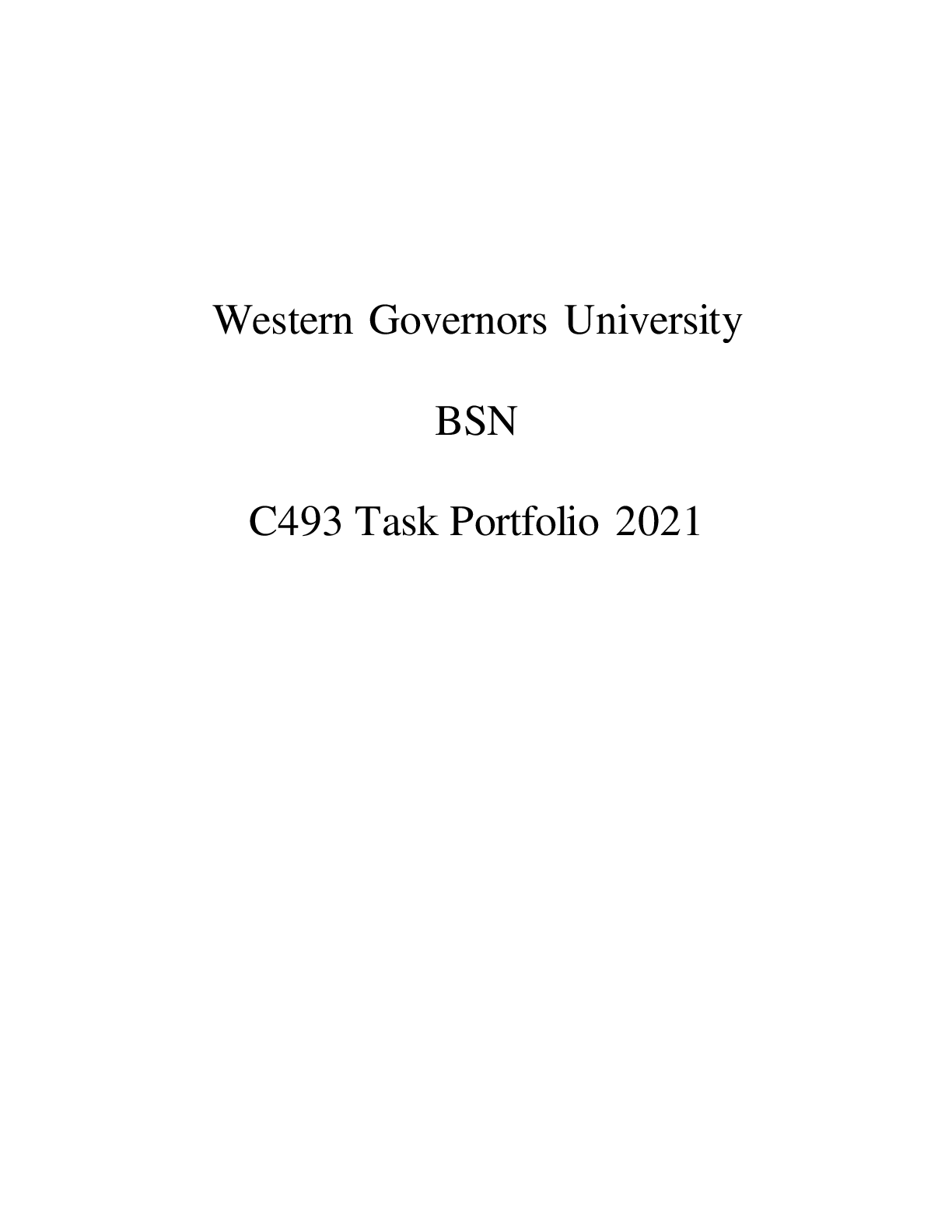
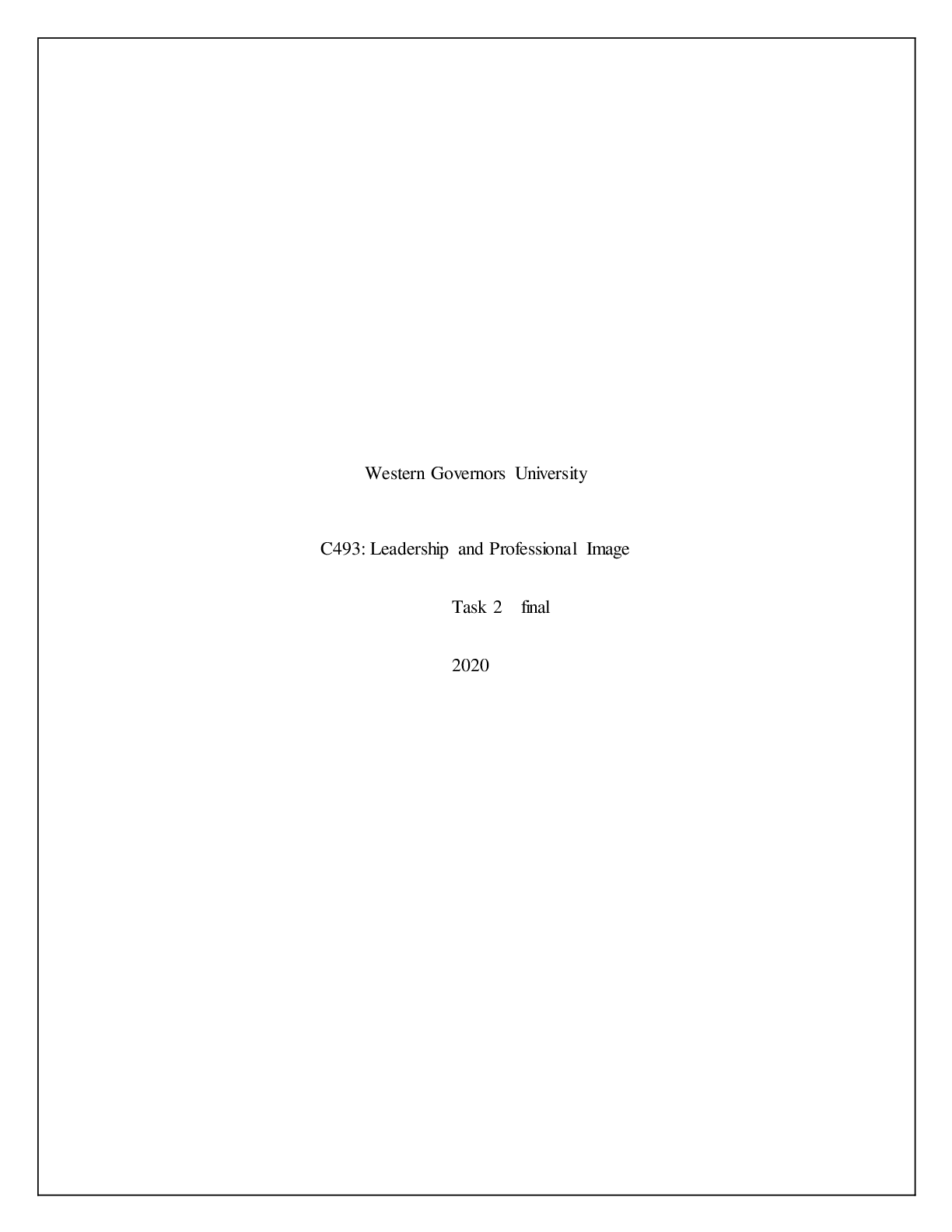
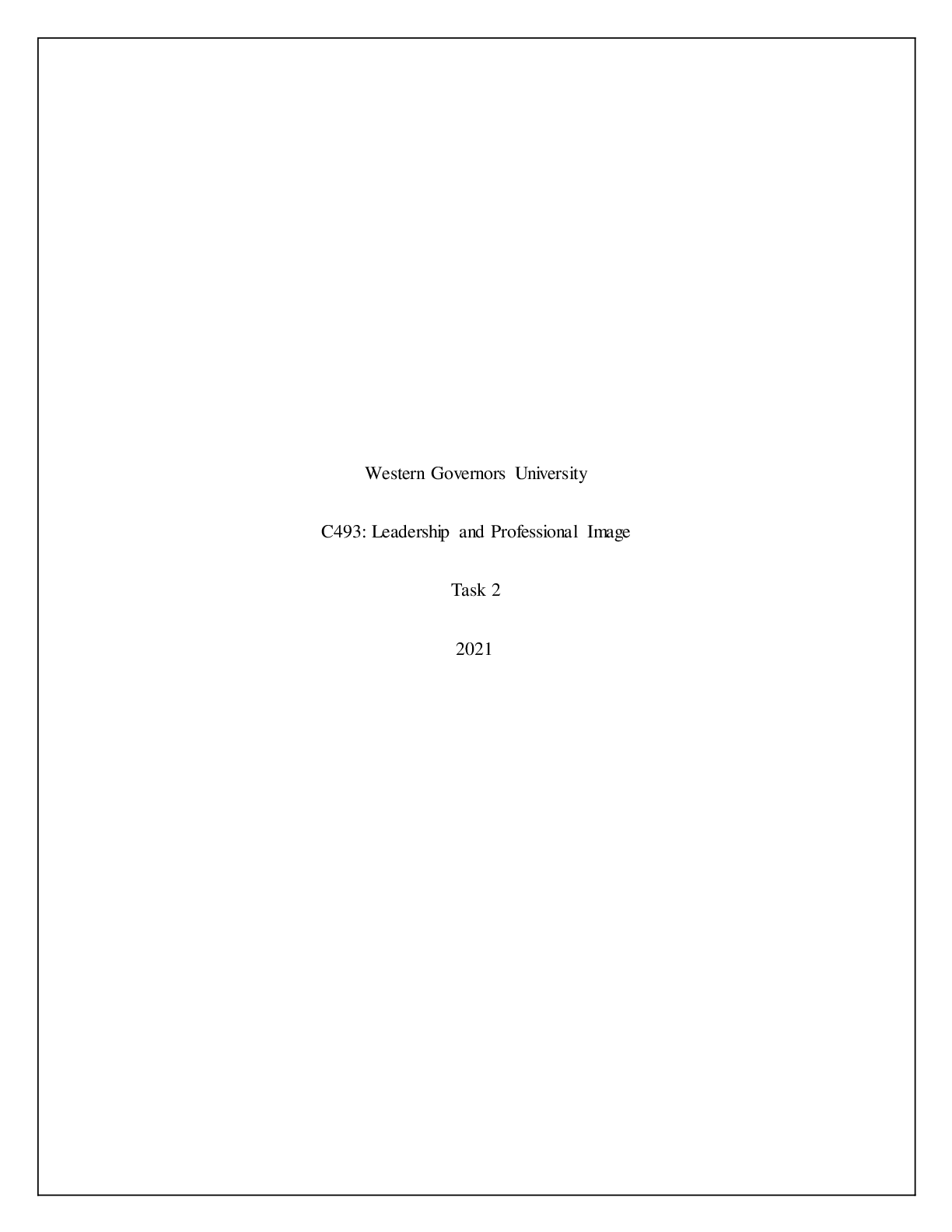
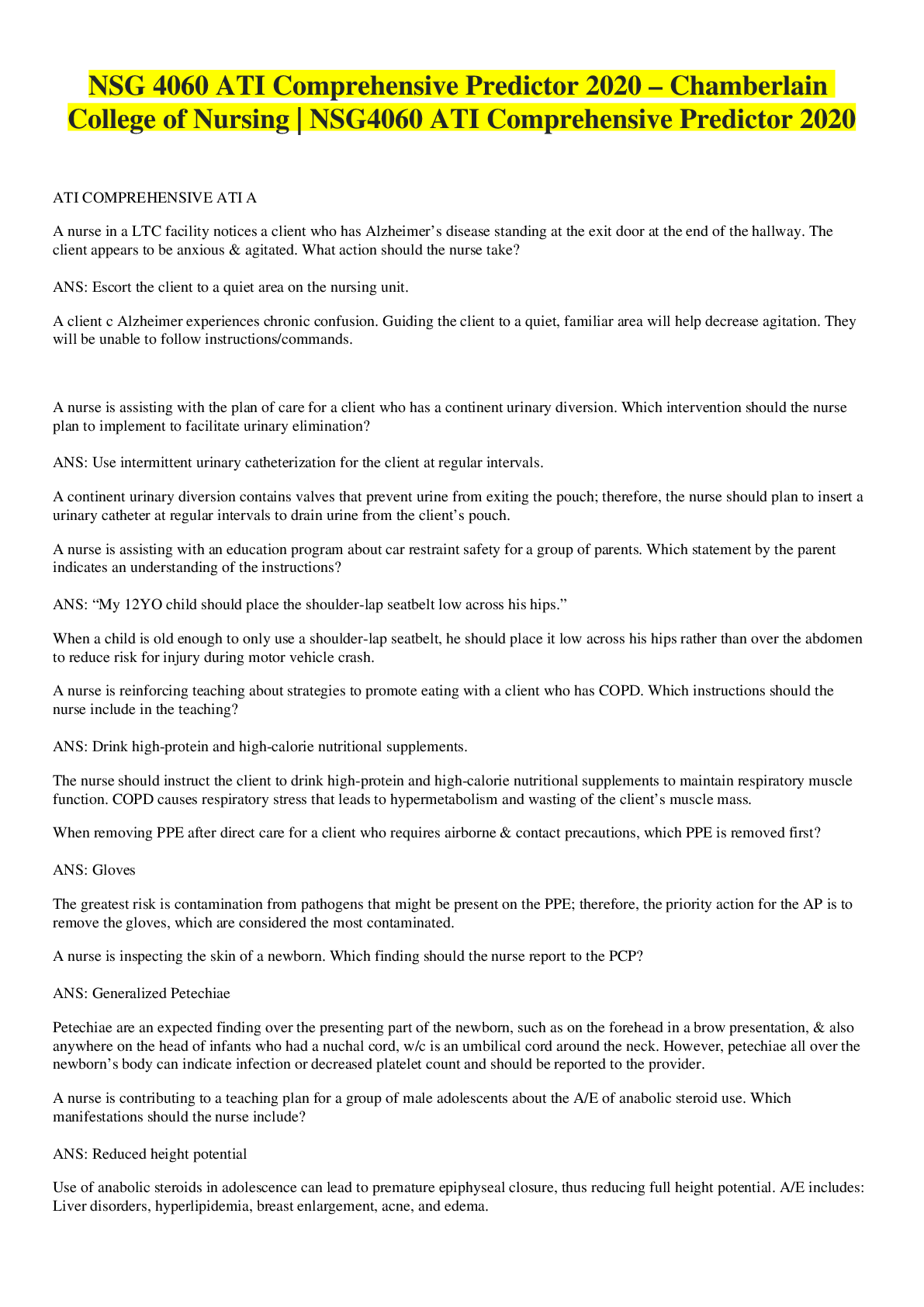

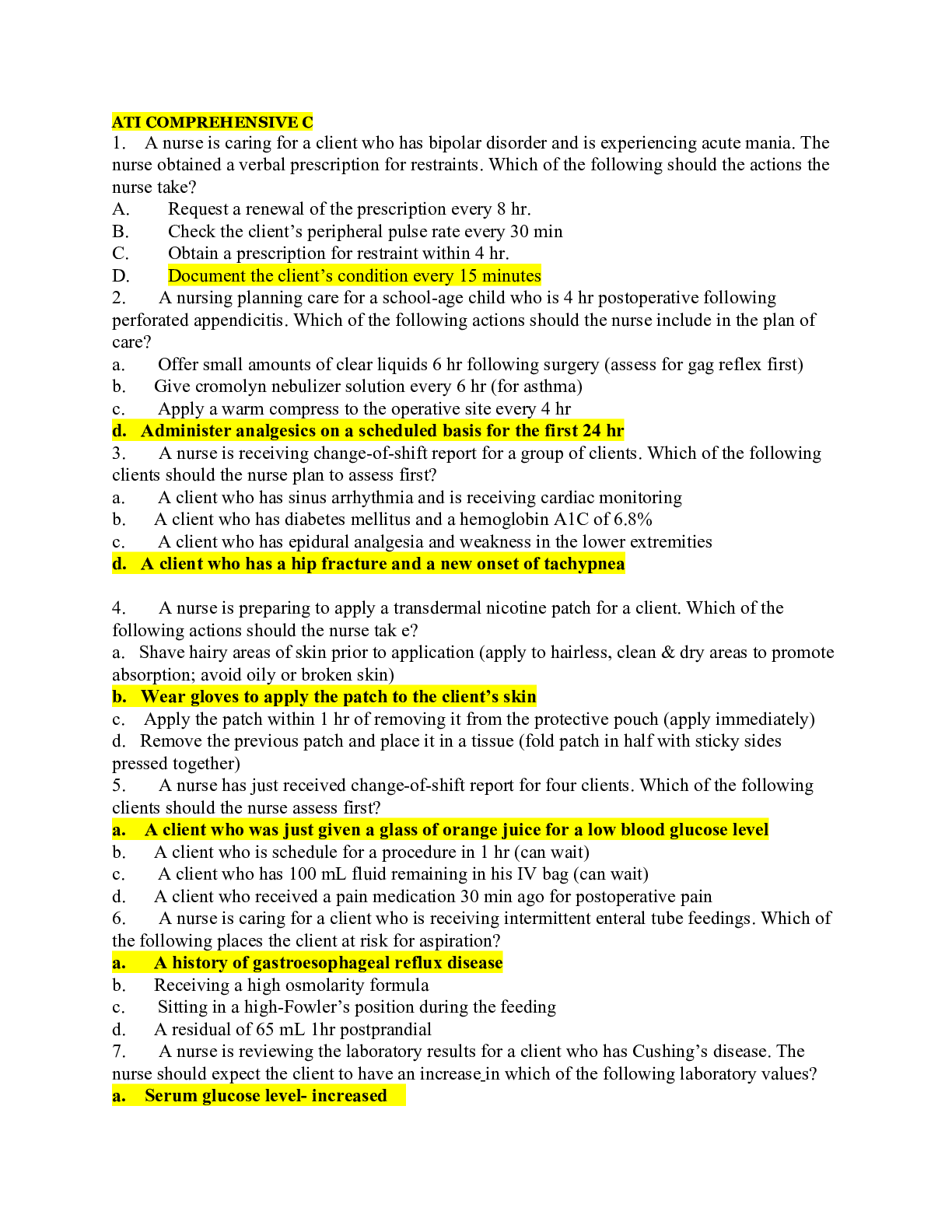
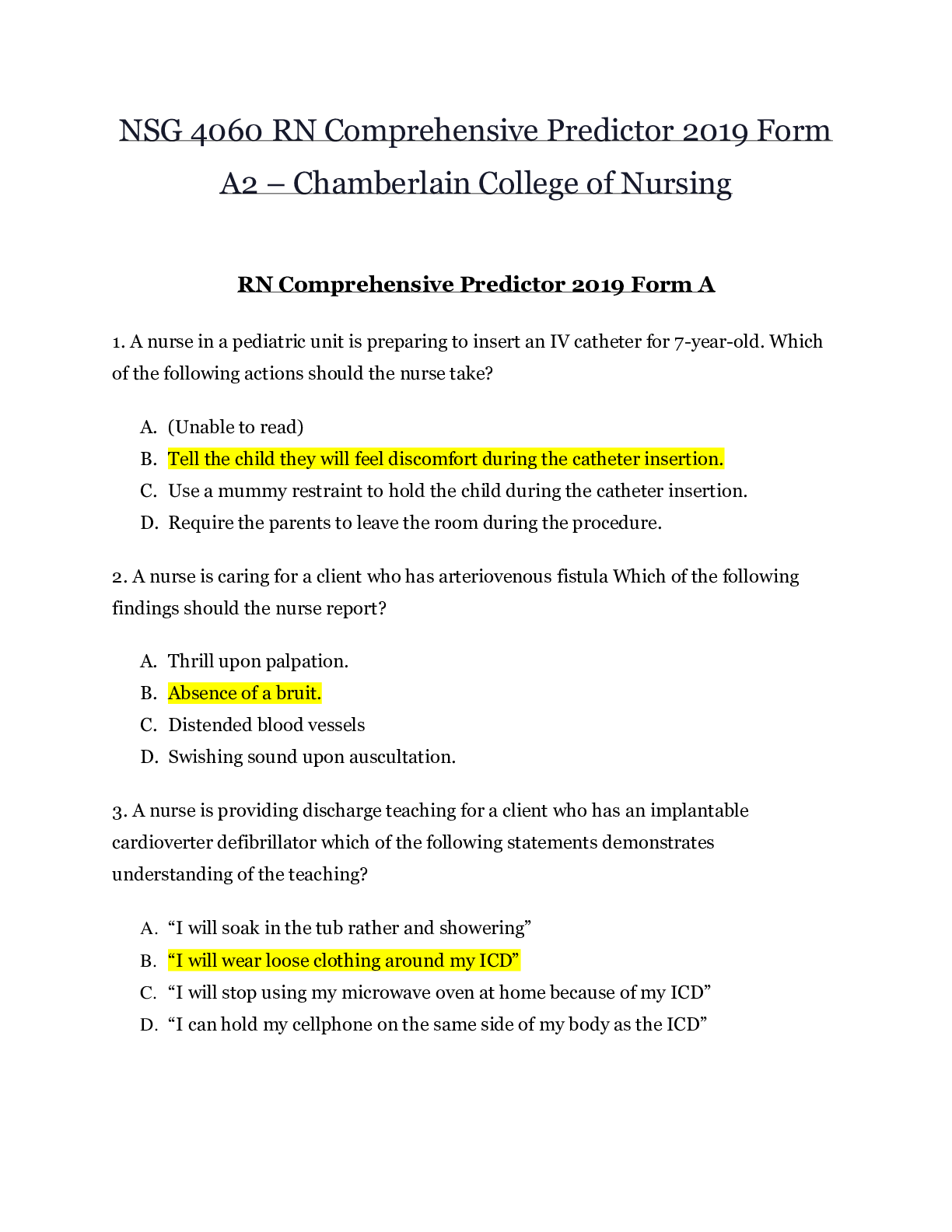
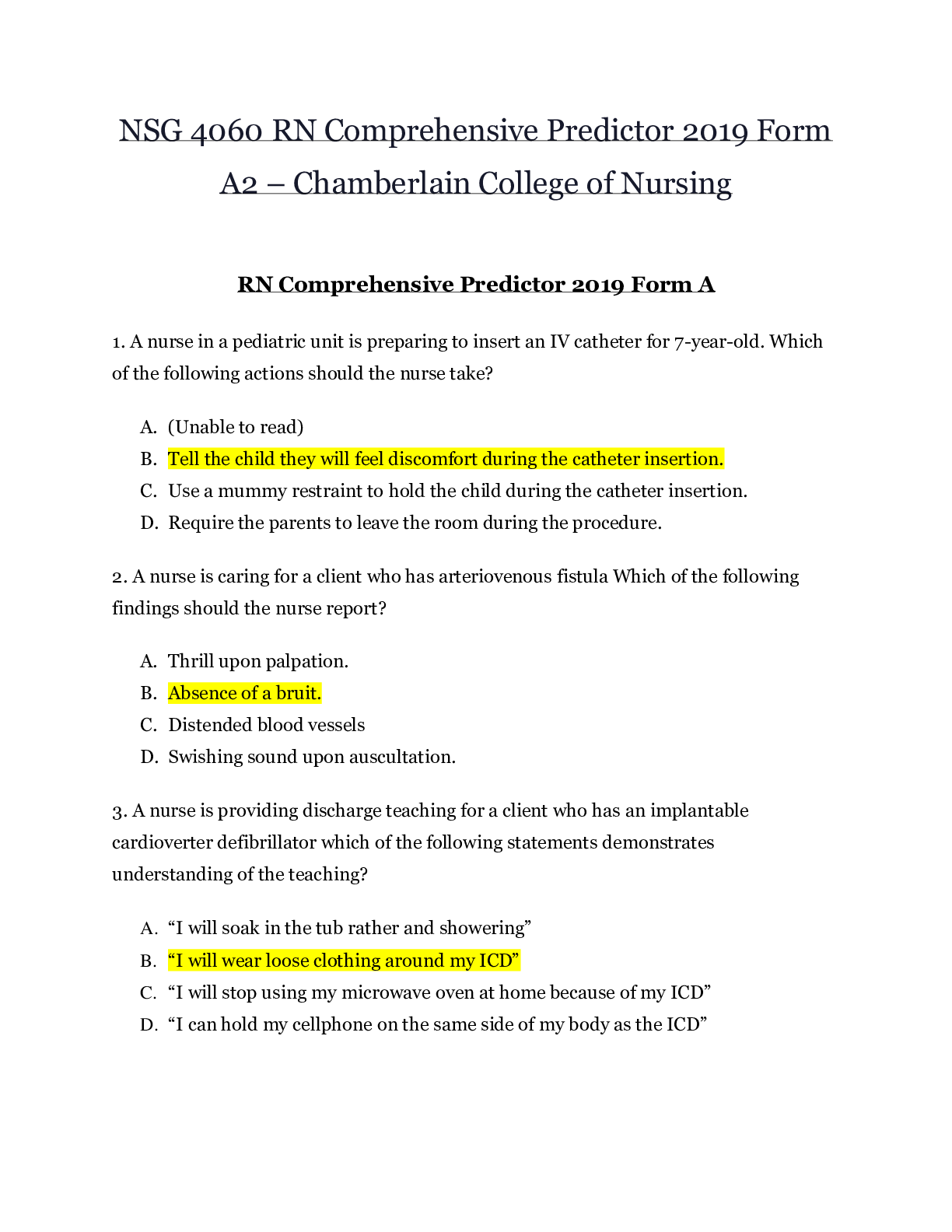

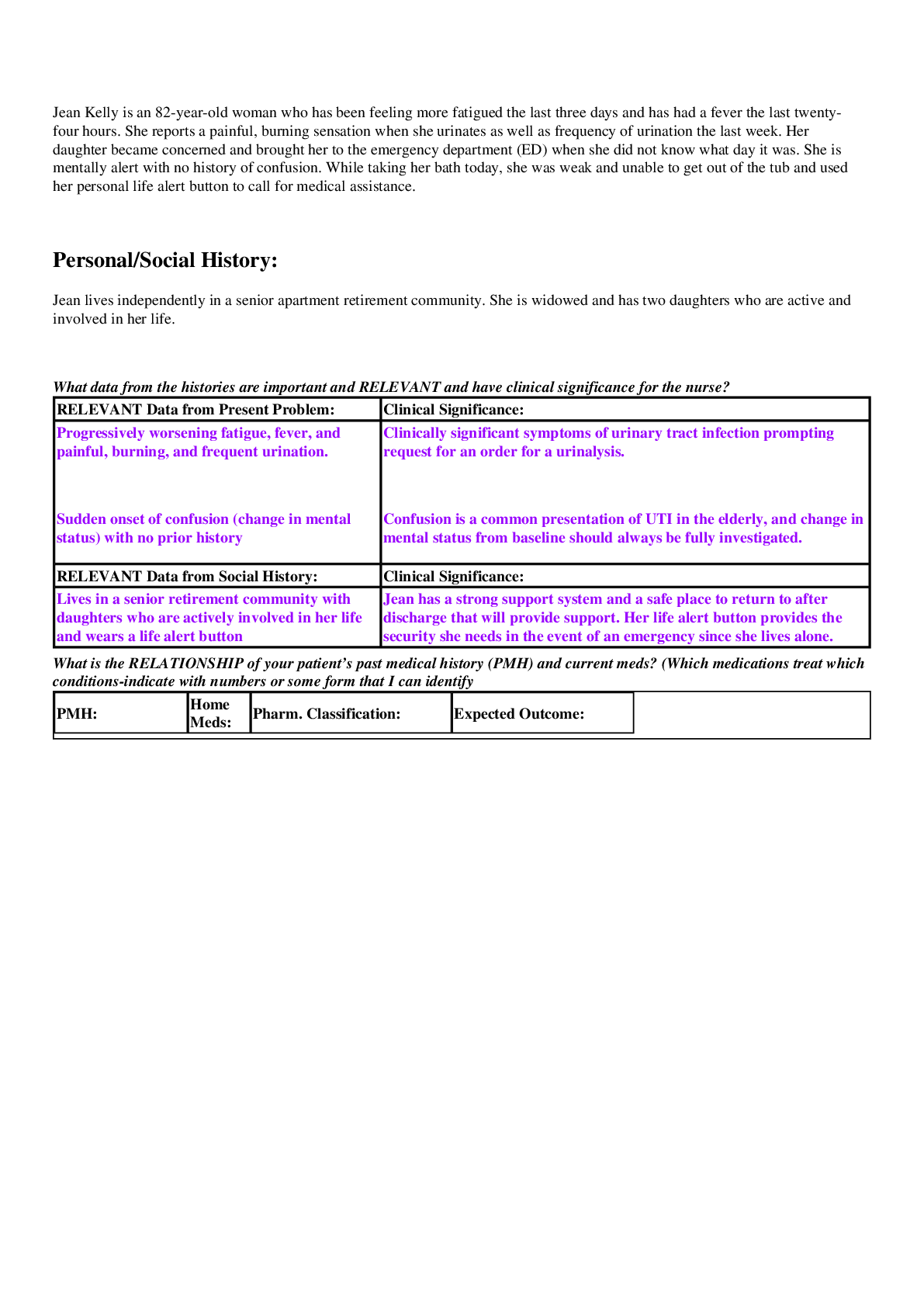
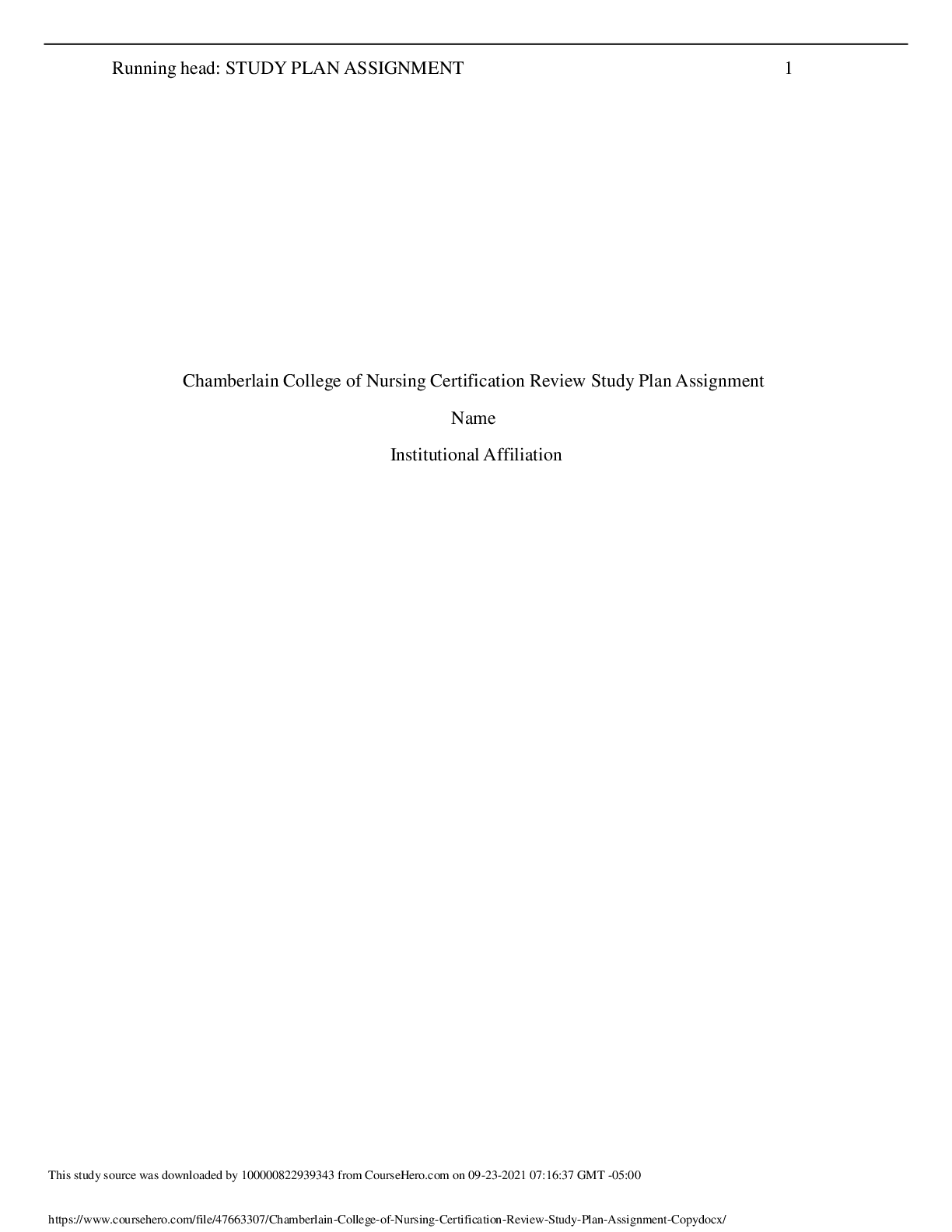
.png)
.png)


.png)
